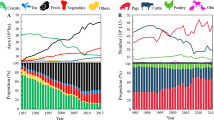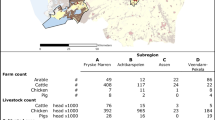Abstract
Agricultural management has its roots in the manipulation of the system to optimise conditions for crop production. It is now widely recognised that this could result in land degradation with subsequent serious impact on crop productivity if the nutrient losses to the agricultural system are not replaced. A nutrient budget is an account of gains and losses of nutrients in an agricultural system, a tool that could be used to develop sound nutrient management and sustainable agriculture. This tool was applied to the annual crop farming system in the highlands of southwestern Uganda to demonstrate (i) within farm nutrient depletion and accumulating zones, and (ii) the extent of nutrient losses at farm and district levels through marketing pathways. Partial nutrient budgets were constructed at field and farm levels using farmer-recorded resource inputs and outputs over a period of one year, and at the district level using annual inventory data of agricultural imports and exports. The computed nutrient balances were highly variable at field and farm levels, but predominantly negative. Nitrogen (N) gains and losses averaged 30.6 and 72.3 kg ha−1 yr−1, respectively in the homestead fields; 10.8 and 33.4 kg ha−1 yr−1 in the outfields; 15.8 and 17.4 kg ha−1 yr−1 at the farm level; and only losses of 5.6 kg ha−1 yr−1 at the district level. Potassium (K) gains and losses followed a similar trend, although less in magnitude. The phosphorus (P) balance was positive but only in the homestead fields and at the farm level. Where agricultural produce were marketed, nutrient losses were reflected more at the higher scales (e.g. district level) and became tied up in pools from which recycling back to agriculture was barely feasible, and with quite alarming monetary implications. Such results can be used to influence policies at different scales on nutrient management.
Similar content being viewed by others
References
African Highlands Initiative 1997. Maintenance and improvement of soil productivity in the highlands of Ethiopia, Kenya, Madagascar and Uganda. AHI Technical Report Series No. 6. AHI Coordinating Office, ICRAF, Nairobi, Kenya.
African Highlands Initiative 1999. Participatory Agroecosystem Management Workshop Report, Kabale AHI Benchmark Site. AHI Coordinating Office, Kawanda, Uganda.
Anderson J.M. and Ingram J.S.I. 1993. Tropical Soil Biology and Fertility: A Handbook of Methods. CAB International, Wallingford, UK.
Bekunda M.A. and Woomer P.L. 1996. Organic resource management in banana-based cropping systems of the Lake Victoria Basin, Uganda. Agric. Ecosyst. Environ. 59: 171-180.
Briggs L. and Twomlow S.J. 1998. Organic material flows within a smallholder farming system of the East African Highlands. In: Briggs S.R., Ellis-Jones J. and Twomlow S.J. (eds), Modern Methods from Traditional Soil and Water Conservation Technologies: Proceedings of a DFID Land Management Workshop. Silsoe Research Institute, Silsoe, UK, pp. 98-113.
Dean B.B. 1994. Managing the Potato Production System. Food Products Press, Binghamton, NY.
De Jager A., Nandwa S.M. and Okoth P.F. 1998. Monitoring nutrient flows and economic performance in African farming systems (NUTMON). I. Concepts and methodologies. Agric. Ecosyst. Environ. 71: 37-48.
Elias E., Morse S. and Belshow D.G.R. 1998. Nitrogen and phosphorus balances of Kindo Koisha farms in southern Ethiopia. Agric. Ecosyst. Environ. 71: 93-114.
Harrop J.F. 1960. Soils of the Western Province of Uganda. In: Memoirs of the Research Division, 1-6. Department of Agriculture, Entebbe, Uganda.
Harris F.M.A. 1998. Farm-level assessment of the nutrient balance in northern Nigeria. Agric. Ecosyst. Environ. 71: 201-214.
IFDC 1999. The fertiliser market in Uganda: An assessment and strategy for development. International Fertiliser Development Centre, Muscle Shoals, Alabama.
Kent N.L. 1983. Technology of Cereals. 3rd edn. Pergamon Press, Oxford, UK.
Lindblade K., Tumuhairwe J.K., Carswell G., Nkwiine C. and Bwamiki D. 1996. More people, more fallow: Environmentally favourable land-use changes in southwestern Uganda. The Rockefeller Foundation, New York.
Lekasi J.K. 1997. Biological management of soil fertility in banana-based cropping systems of Uganda, M.Sc. Thesis, Makerere University, Kampala, Uganda.
MAAIF 1998. Operationalisation of the medium-term plan of the modernisation of agriculture in Uganda, 1997/98-2001/ 02. Ministry of Agriculture, Animal Industry and Fisheries, Entebbe, Uganda.
MFEP 2000. Statistical Abstracts, 2000. Ministry of Finance and Economic Planning, Entebbe, Uganda.
Thung M. 1991. Bean agronomy in monoculture. In: van Schoonhoven A. and Voysest O. (eds), Common Beans Research for Crop Improvement. CAB International, Wallingford, UK, pp. 737-834.
Vanden Bosch H., Gitari J.N., Ogaro V.N., Maobe S. and Vlaming J. 1998. Monitoring nutrient flows and economic performance in African systems: Monitoring nutrient flows and balances in three districts in Kenya. Agric. Ecosyst. Environ. 71: 63-80.
Van Noordwijk M. 1999. Nutrient cycling in ecosystems versus nutrient budgets of agricultural systems. In: Smaling E.M.A., Oenema O. and Fresco L.O. (eds), Nutrient Disequilibria in Agroecosystems: Concepts and Case Studies. CAB International, Wallingford, UK, pp. 1-26.
Wortmann C.S. and Kaizzi C.K. 1998. Nutrient balances and expected effects of alternative practices in farming systems of Uganda. Agric. Ecosyst. Environ. 71: 115-130.
Author information
Authors and Affiliations
Rights and permissions
About this article
Cite this article
Bekunda, M., Manzi, G. Use of the partial nutrient budget as an indicator of nutrient depletion in the highlands of southwestern Uganda. Nutrient Cycling in Agroecosystems 67, 187–195 (2003). https://doi.org/10.1023/A:1025509400226
Issue Date:
DOI: https://doi.org/10.1023/A:1025509400226




